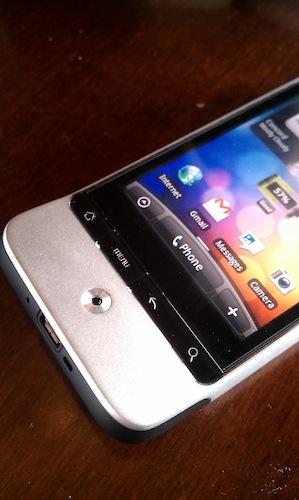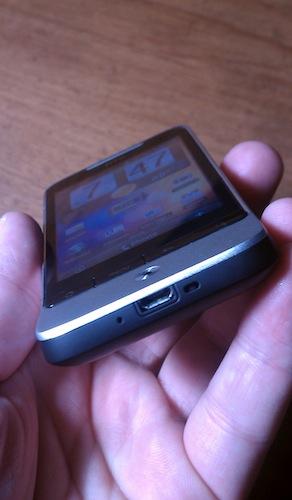
What's Good: Gorgeous hardware; not laggy thanks to upgraded processor and Android 2.1.
What's Bad: No US version just yet, so purchasers are stuck with EDGE.
Verdict: The HTC Legend is a great mid-range Android device, and the most beautiful Android phone I've worked with to date. I just wish it was available on AT&T or T-Mobile.

Announced several months ago, I can honestly say that I wish the Legend would come to the United States. Designated as the successor to the HTC Hero, the unibody aluminum frame is absolutely gorgeous. Though the device offers physical buttons below the display instead of the capacitive touch buttons we're used to on devices like the DROID, Incredible, and EVO 4G, it does offer HTC's optical trackpad and Android 2.1. That being said, is the HTC Legend's beauty the only thing going for it, or is it worthwhile under the hood as well?

Coming in at 4.41 inches long by 2.22 inches wide by 0.45 inch thick, the device weighs 4.44 ounces, making it one of the lighter Android-powered smartphones on the market. The Legend offers a 3.2-inch 320 x 480 HVGA AMOLED touchscreen, and while it's no 3.7-inch display, it gets the job done. The device is powered by a 600 MHz Qualcomm processor and offers 512 MB ROM, 384 MB RAM, Android 2.1 with HTC's Sense UI, 3.5mm headphone jack, and a microSD card slot with support for up to 32 GB. Save for the plastic surrounding the camera and the battery door, the HTC Legend is made of one piece of aluminum. Resembling something from the Apple MacBook Pro line, it's absolutely gorgeous, and I found myself wishing that every HTC Android device was made this way.

Since the Legend I'm working with is unlocked and unbranded, packaging will likely change depending on what country it is sold in. That being said, the device shipped with an AC adapter, USB cable (which doubles as the charging cord), and earbuds. The device itself is incredibly minimalist in design, with the only physical buttons (besides the four on the front of the unit) being the volume rocker and the power button. The Legend also offers a 3.5mm headphone jack and HTC's new optical trackpad. The camera, speaker, and battery/SIM card door can be found on the back.

On that topic, the HTC Legend's battery compartment is different than any other device I've seen in recent years. To access, simply slide the bottom plastic piece down, and pull back on the clear plastic piece underneath. From there, you'll see the SIM card slot, microSD card slot, and battery area. It's unique and amazing, really. All in all, it's quite the solid device, and it's nice to see that a good level of detail went into a mid-range device.

The Legend offers Android 2.1 with HTC's Sense UI installed over it. I've said it before, and I'll say it again - though 2.1 (and 2.2, by the time you're reading this) have done a great job bridging the divide, I still think the vanilla version of Android is ever-so-slightly unrefined. Simply put, HTC has done an absolutely fantastic job with the Sense overlay, and in my opinion, it makes the device perfect for the regular consumer. All in all, it will ultimately boil down to personal preference, but as someone who is well-versed in all versions of Android, I still prefer carrying a Sense-enabled device.
I've always liked HTC's custom keyboard that is found on the company's Sense-equipped handsets, and that doesn't change with the Legend. It's easy to type on, offers fantastic auto-correction services, and has no lag whatsoever (a welcome change from the Hero and DROID Eris). I was able to type out e-mails, text messages, and instant messages with ease.

The Legend offers the same 5.0-megapixel camera that is used on the DROID Eris and Hero, and picture quality was just as good. Colors were crisp, and the autofocus works well. Editing options include brightness, contrast, saturation, sharpness, color effect, white balance, resolution (four different options), quality (high, fine, or normal), and more.

In regards to battery life, the Legend offers just over 7 hours of talk time, and 560 hours of standby time. Though it was used on EDGE during the test period, the Legend performed well in battery life tests. With moderate to heavy use including calling, text messaging, instant messaging, browsing the internet, use of Google Maps, and browsing through the Android Market, I was able to make it just under 1 1/2 days before the device powered down. Though it's no battery life champion, it seems to fall right in line with other mid-range Android devices on the market.

The Legend I've been working with is an unlocked European version (supporting 3G in the 900 and 2100 MHz bands), so I haven't been able to test anything beyond EDGE on T-Mobile and AT&T. Still, data speeds were reasonable given the network limitations, and call quality was very good on both networks. Callers were able to hear me, and I was able to hear them without issue. I took the device to a known T-Mobile and AT&T trouble spot in the Charlotte metropolitan area, and found the call quality to be very good, even with no "bars" of service. Speakerphone worked well in the busy department store it was tested in, and my Plantronics Voyager Pro headset connected without issue.

Are there other Android devices on the market that are more powerful? Yes. However, when looking at the Legend as the successor to the HTC Hero (which is what it is), it puts it into perspective. The unibody design is absolutely gorgeous, the optical trackpad is a welcome improvement, and the improved processor combined with Android 2.1 makes this my favorite mid-range Android device to date. I'd just like to see it in the United States (with support for AT&T or T-Mobile's 3G) at some point.